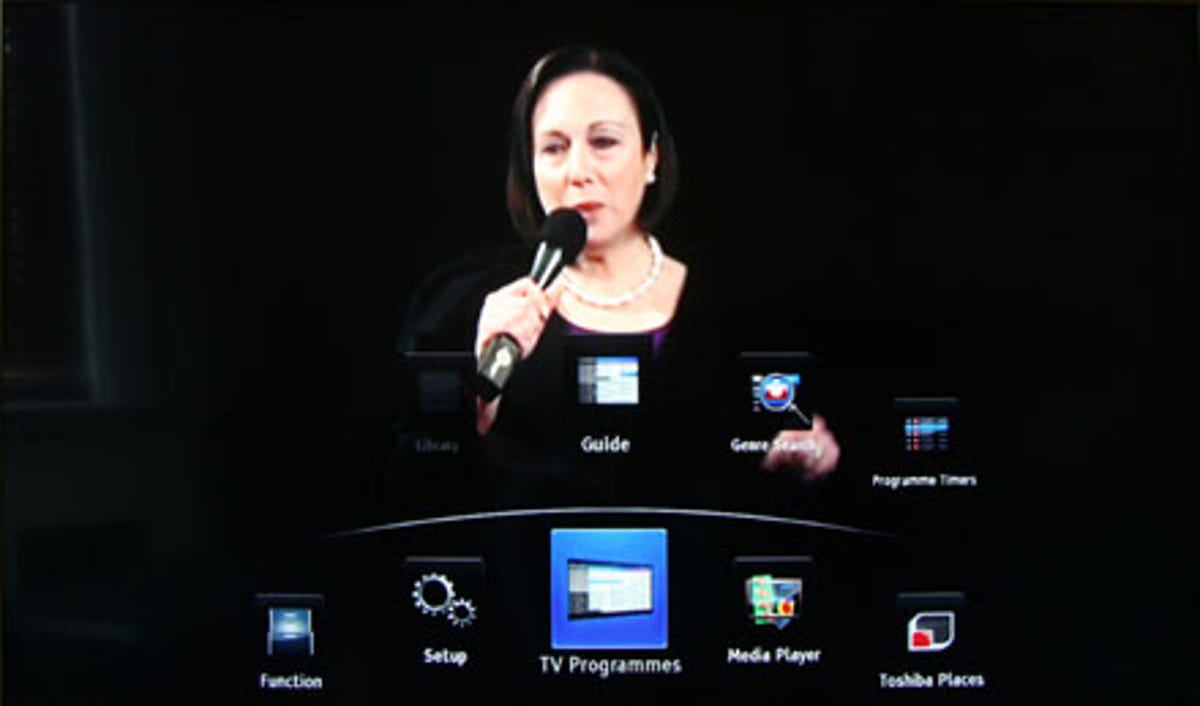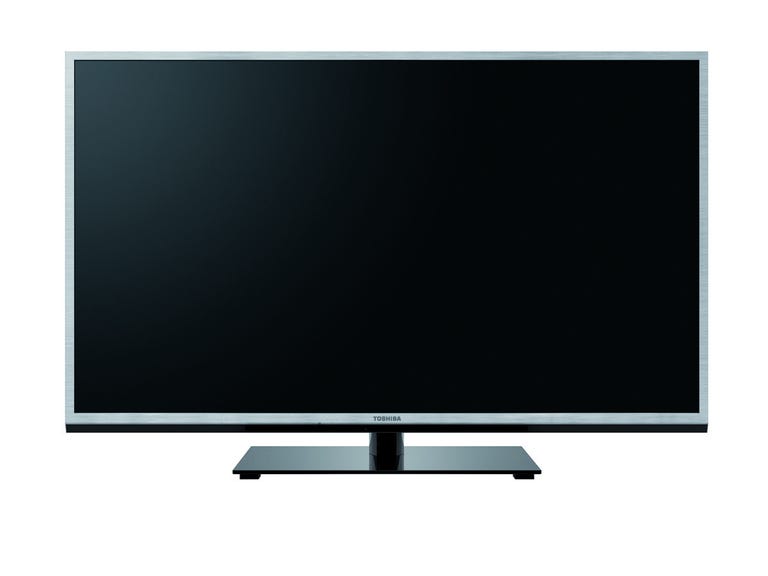 Why You Can Trust CNET
Why You Can Trust CNET Toshiba 46TL968 review: Toshiba 46TL968
The Toshiba 46TL968 is one of the cheaper 46-inch sets around and is capable of producing some impressive HD pictures.
Over the last few years, when it comes to TVs Toshiba has avoided entering into an arms race with other manufacturers to see who can stuff their sets full of the latest features. Instead it has focused on offering good looking TVs with often eye-catchingly low price tags.
The Good
The Bad
The Bottom Line
The 46TL968 continues this trend, as despite having a slim bezel that's very 'now' and packing in active 3D support and 200Hz motion processing, you can buy this mid-range 46-inch model online for as little as £550.
User interface and EPG
The menu system on the TL968 is quite different to what you find on most rival TVs. It doesn’t use the homescreen concept adapted by LG and Samsung, nor does it have the flatter style menus found on Panasonic’s sets.

Instead when you hit the Menu button on the remote it calls up two arcs of icons at the bottom of the screen. In the first arc you select the type of task you want to perform, such as changing the setup, selecting TV programmes, or accessing the media player and this then shunts you into the upper arc where you can choose the specific function you want to access. Once you've chosen setup, you can then pick from picture, sound, preferences and system options, while selecting the media player gives you the options of choosing the USB or network player.
Toshiba has added colourful icons and animations to the menus, but the drab black and grey backgrounds mean it still doesn’t look anywhere near as visually appealing as the menus on LG and Samsung’s TVs. Also, moving around the various screens can feel a little long-winded, as skipping back and forth through the two arcs can be a tad tedious after a while, especially if you’re trying to make multiple corrections to the picture presets.
Like some other mid-range sets we’ve seen recently, such as the ES6800 from Samsung, the TL968 has both Freeview HD and Satellite HD tuners on board. Unlike Samsung, Toshiba hasn’t localised the satellite tuner on its sets, so it doesn’t conform to the Freesat HD spec. When you tune in to satellite channels it just tunes all free to air channels and dumps them in a jumbled channel list. The EPG also fails to fully populate with programming information for them. Because of this, unless you want to use the TV with a foreign satellite service, it's only really the Freeview HD tuner that's of use on this set.
The EPG doesn’t have a video thumbnail window, but when you call it up it does at least keep the audio running, so you don’t entirely lose track of the show you’re watching. Its design isn’t all that easy on the eye, but on the plus side it shows thirteen channels of programming info at once, and you can use the channel up and down buttons to quickly move through it in large blocks of channels.
Digital media and Internet features
Toshiba’s smart TV platform is called Places, and unfortunately -- despite the addition of some extra content lately -- it still lags far behind TVs from companies such as Samsung and Sony.
The Places system is divided up into a series of hubs for TV, Video, Music, Social Networking, News and Games. Unfortunately, many of these subcategories are pretty sparsely populated. The TV section, for example, only includes an iPlayer app and the Media Guide online EPG, so you don’t get support for ITV Player or Demand5. And while the Video section now includes apps for Blinkbox, Acetrax, YouTube, Vimeo and DailyMotion, it lacks support for big hitters like Netflix and Lovefilm, which are available on most rival smart TV platforms.
Toshiba has also now added a full Web browser, but this is rather a chore to use via the remote control, and unfortunately doesn’t support Flash for video playback.
Nevertheless, there are two on-board media players. One of these is used for playing back digital media files from USB drives, while the other is used for streaming files across a network from network-attached hard drives or DLNA devices such as PCs and laptops.
In the past, Toshiba’s TVs have refused to stream MKV files over a network unless they were coming from Windows 7 PCs, but thankfully the company has fixed this issue on the TL968. I found it was happy to play a wide range of formats including MKV, DivX and MP4 files, both locally from USB drives and remotely from DLNA networked devices. The set also supports Intel WiDi (Wireless display), so if you've got a WiDi compatible laptop you can hook it up to the TV wirelessly.
Design and connections
The 40RL868 isn’t the most stylish TV I’ve ever clapped eyes on. Its finish is on the plasticky side -- especially the fake brushed metal effect used on the bezel -- and this cheapens its overall appearance somewhat. That said, the TV is far from ugly. I like the sloping mirrored panel at the bottom of the TV, and the bezel is actually reasonably narrow too.
The remote control is rather large, but it still feels relatively comfortable to hold and the sensible button layout means all the key functions -- such as the channel, volume and EPG -- are within easy reach of your thumb.
On last year's range Toshiba dropped the ball when it chose not to include Wi-Fi on its sets, just at the point where most other manufacturers decided it was a must-have. Thankfully on this model it’s righted that wrong, as the 40RL868 comes with integrated Wi-Fi as well as a wired Ethernet port.
Unlike Samsung, it hasn’t skimped on HDMI ports either, as you’ll find three of them mounted on a panel on the rear, and another one side mounted for easy access if the set is wall mounted. The rear is home to both RF and satellite inputs for the Freeview HD and Satellite HD tuners and there are also full-sized Scart, component and PC VGA inputs.
There’s a pair of USB ports too, with one side mounted and the other positioned on the rear, while the optical audio output makes it easy to feed audio from either of the tuners to an external surround sound amp. All in all, it’s got all of the key connectivity basis nicely covered.
Audio quality
The 46TL968’s chassis tapers out at the bottom to make room for its speakers. Sadly this hasn’t really helped its audio quality to the degree that this trick has on some other sets that I’ve had in for review.
To be fair, mid and high frequencies are reasonably well dealt with, so it doesn’t suffer from the muddied dialogue problem that Panasonic’s E5 and ET5 ranges exhibits. That said, its audio quality remains decidedly middling.
Like many thin-screened TVs, its sound quality suffers from quiet, weedy bass response. You can boost this by cranking up the bass setting in the advanced audio menu. While this adds more bass into the mix, it still sounds very boxy and doesn’t have the fatness that you get on TVs with superior sound systems, such as those on Philip’s high-end models.
2D picture quality
The 46TL968's images are certainly not the strongest around, but given the set's relative low price tag, that's understandable. In terms of black level performance and backlight consistency, it's a long way from the likes of Sony's excellent HX853 model. Its pictures do tend suffer slightly from backlight pooling, so this is not really an ideal option for those who tend to watch movies with the lights turned down in the evening. This is the type of viewing environment that shows up the backlight problems at their the worst.
The TV often struggled to deliver really satisfying standard-definition performance too. Colours tend to look muddier and less distinct in standard definition than they do when it's detailing with high-definition sources. Despite having Toshiba's Resolution+ picture processing system on board, I didn’t think upscaling performance was wonderful. It had a real tendency to highlight noise around peoples faces or on scrolling text on news broadcasts. You also have to be careful with its motion processing, as on all but the lowest setting it tends to introduce image flickering and tearing around moving objects.
The set is miles better when dealing with high-definition sources though. Suddenly its colour palette seems to really open up, delivering stronger and richer colour blends and much more contrast depth. This is very noticeable on tricky skin tones or darker, more noirish scenes. Motion performance seems to be better too, and sharpness levels in HD are very strong, especially for a TV in this price range.
3D picture quality
Toshiba isn’t really pushing this set's 3D capability. In fact it doesn't even include any 3D specs in the box. The TV uses active 3D technology, so its glasses are relatively expensive -- you'll pay around £30 a pair for them online.
This model's 3D pictures aren't too shabby, but it's not a barnstormer in this department either. Its 3D pictures are bright, which goes some way towards cancelling out the dimming effect of the active glasses, and colours tend to look quite rich and bold. The set's motion processing can’t be enabled in 3D mode however, and there's noticeably more judder and blurring on its 3D pictures as a result. The TV also suffers from a fair bit more 3D crosstalk than most of its mid-range rivals, so you often see some image ghosting in the mid-distance in 3D scenes.
Conclusion
The 46TL968 has its problems. Its smart TV system isn’t great, its upscaling could be better and it suffers from backlight inconsistencies. On the other hand, it's also one of the cheaper 46-inch sets around from a big name manufacturer and is capable of producing some impressive HD pictures. It wouldn't be my first choice if I was on the hunt for a 46-inch model, but if money is tight, it's still worth a look.


